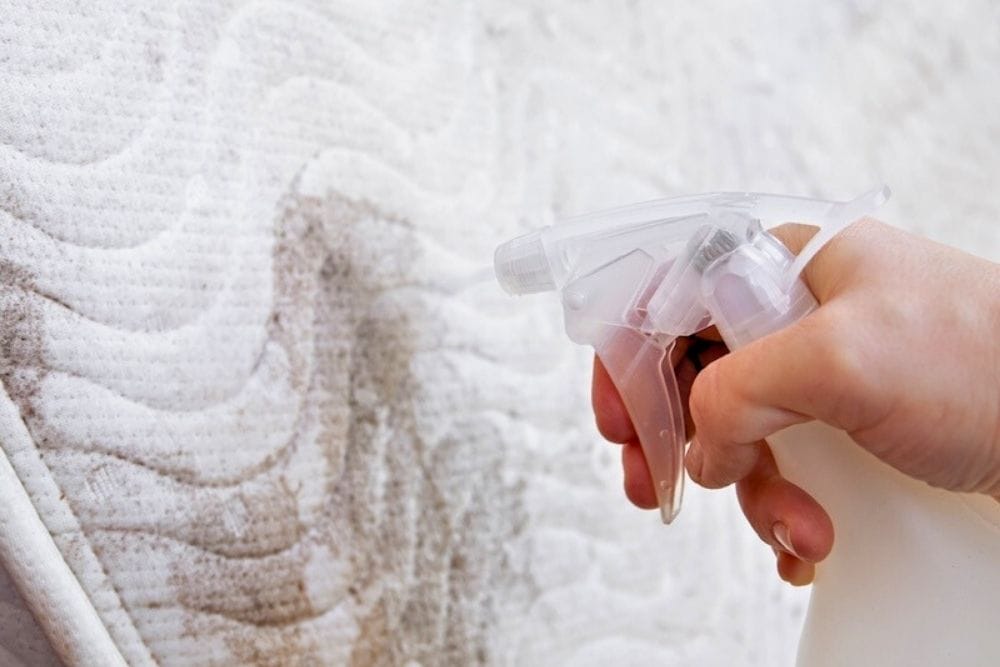Doesn’t it feel so good when it’s time to make up the bed and you get to sleep on fresh sheets? Sometimes, though, we’ll strip off the bedding only to discover a mattress stain or two… or more.
Sure, it’s tempting to think that the sheets will cover up the stain, so who’s going to notice? But keeping your mattress clean is an essential part of a comfortable, hygienic bed setup — and a good night’s sleep.
It’s best to remove mattress stains ASAP so they don’t set into the fibres or invite mould and bacteria. How you tackle them will depend on what caused the mess.
If the stain is fresh, start by blotting up any excess liquid. Then choose the appropriate mattress stain remover, such as white vinegar, hydrogen peroxide, or enzyme cleaners.
Don’t let those bothersome blotches bug you at bedtime. (Say that three times really quick!) Roll down the bedding and roll up your sleeves — here’s how to get stains out of a mattress.
Choosing A Mattress Stain Remover | Before Cleaning | Sweat Stains | Blood Stains | Drink Stains | Vomit | Urine Stains
Different Types of Mattress Stains
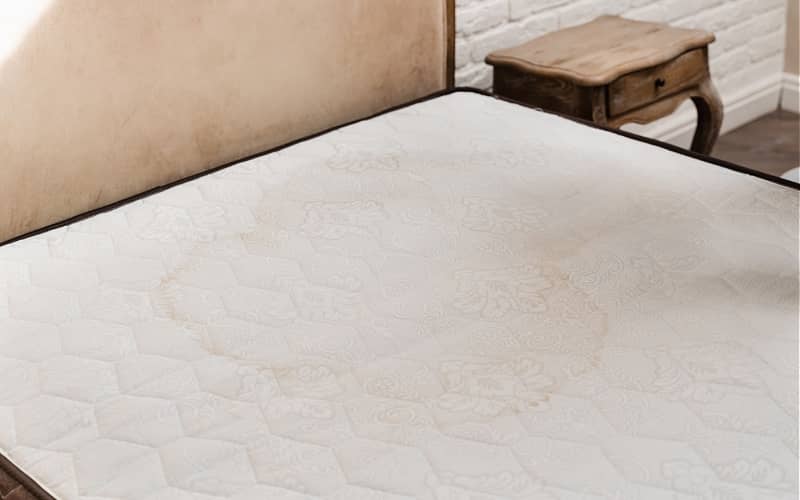
Lots of things can create stains on your bed, from a pet accident to your nightly cup of tea! Sweat, body oils, and other dirt also accumulate on a mattress over its lifetime.
We’ve broken down the most common types of mattress stains and what you’ll need to know before cleaning.
SWEAT STAINS: Sweat is one of the most common mattress stains, since we naturally produce sweat and body oils even while sleeping. It’s usually less difficult to clean compared to other messes.
BLOOD STAINS: Blood proteins can easily stick and set into a mattress, so it’s hard to remove when dry. On the plus side, blood typically doesn’t soak too deep, so the stains will be more on the surface.
DRINK STAINS: Spilled drinks such as tea, wine, and coffee can easily leave stains on a mattress. Your main concern will be the tannins, which give those drinks their colour. Dark-coloured drinks are harder to remove.
VOMIT STAINS: These may be the most intimidating stains since vomit can make a big mess. You’ll need to act quickly to ensure the stain doesn’t dry out and cake on the mattress surface.
URINE STAINS: Pee stains are the hardest to tackle since urine quickly soaks into a mattress and leaves a strong odour. Moreover, if left untreated, urine can become a health hazard due to bacteria and mould.
What’s the Best Mattress Stain Remover?
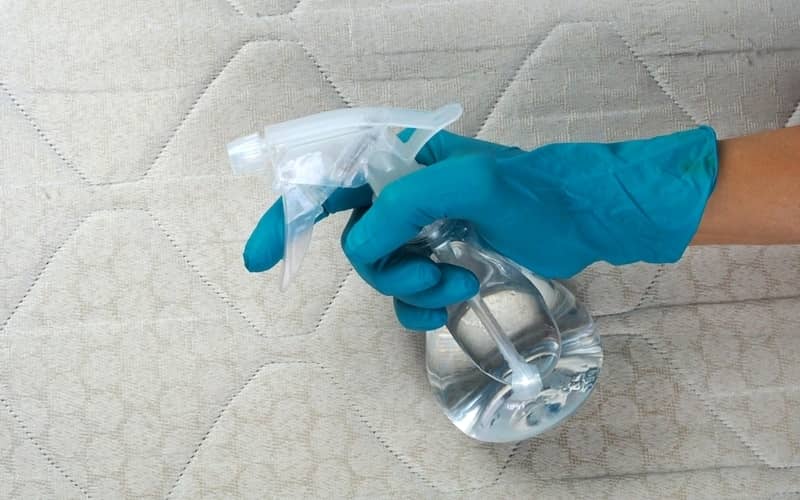
The short answer is — it depends on the type of stain and mattress.
Each stain has its own cleaning process, although there are cleaners that work on multiple messes!
Some effective, multi-purpose mattress stain removers include:
- White vinegar
- Enzyme cleaners
- Hydrogen peroxide
You’ll also need to make sure your chosen cleaner is compatible with your mattress. Check the care label or the manufacturer’s website for specific instructions or products to avoid.
(That way, you don’t accidentally void your mattress warranty!)
In general, steer away from products with bleach and similar harsh chemicals. These can damage the mattress material and leave a residue that causes skin or respiratory irritation.
Before Cleaning Mattress Stains
As much as possible, get stains out of the mattress right away. Fresh stains are easier to deal with — the longer a stain sits, the harder it’ll be to remove.
Start by stripping the bed, including any pillows and blankets. Pre-treat any stains before washing the bed sheets, as well as any mattress toppers or non-waterproof protectors.
If your mattress has an all-over cover, check the care label for instructions on how to take it off and wash it.
Wear rubber gloves and a face mask when cleaning, and open any windows so you’re working in a well-ventilated room.
Use paper towels or old towels to blot up excess moisture. For fresh, “wet” stains like urine, layer towels over the affected area and gently press down to “squeeze” out the liquid from the mattress.
Do not rub or scrub a stain, since that could push the stain deeper into the mattress or make it bigger.
For a foam mattress (especially memory foam), minimise any liquids used when cleaning! Foam is very absorbent, and any trapped moisture could cause mould or mildew growth.
How to Remove Sweat Stains From a Mattress
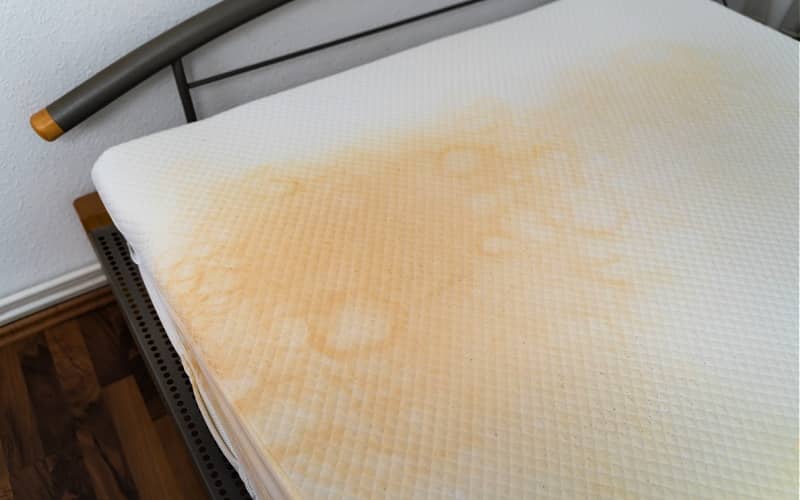
Sweat and body oils accumulate on your mattress over time, so the stains don’t show up right away (unlike blood or urine).
Regular mattress cleaning will help prevent a build-up of sweat and keep things fresh. Otherwise, if left too long, sweat stains on a mattress can turn dark and develop a funky odour.
They can also invite bacteria to grow and spread.
Using white vinegar
Vinegar is one of the quickest solutions for removing mattress stains, especially fresh ones.
Pour a cup or two of white vinegar into a spray bottle, then lightly spray the stained area. Wait a few minutes before blotting the mattress with a fresh cloth.
Repeat the process until the stain has lifted, then let the mattress air dry. The vinegar scent should dissipate as it evaporates.
If the sweat stain is small, you can quickly neutralise the vinegar scent with a few tablespoons of baking soda. Sprinkle a small amount onto the mattress and leave it for a few hours.
When the baking soda has dried, use a soft brush to “sweep” the residue into the rubbish bin.
NOTE: Do not use a vacuum cleaner on baking soda! It can clog your machine’s filter and get into the motor, especially for models without a bag or HEPA filter.
Using hydrogen peroxide and baking soda
For stubborn or old yellow sweat stains on a mattress, you’ll need to bring out the tough stuff.
To start, sprinkle a light layer of baking soda onto the stain. Then make a DIY mattress stain remover spray by mixing a cup of hydrogen peroxide with a few drops of liquid dish soap in a spray bottle.
Generously spritz the peroxide mix onto the baking soda — and be mindful of the fizzing! Scrub the mattress surface with an old toothbrush, going from the outside of the stain to the middle.
Let the solution sit for 5–10 minutes before wiping off the residue with a damp cloth. Repeat if necessary until you’ve removed the mattress stains.
Dispose of any unused cleaning solution afterwards. Don’t keep it, as the mixture can bubble over and create another mess for you to deal with.
Using a stain remover powder
Looking to remove sweat stains from a mattress without hydrogen peroxide? Try a stain remover powder (or, if you already have it, powdered laundry detergent).
Some good options include OxiClean Stain Remover or Sard Super Power Stain Remover.
Dampen the sweat stain with a soft cloth and cool water. In a small bowl, mix 3 tbsp of stain remover powder with a cup of warm water to make a cleaning paste.
Spread the paste over the mattress stain and let it sit for a few hours. Wipe off the residue with a damp cloth, then apply more paste as needed.
For stubborn stains, you can carefully scrub the mattress with a soft-bristled brush.
Blot away excess moisture with a fresh towel and let the mattress air dry.
How to Get Blood Stains Out of a Mattress
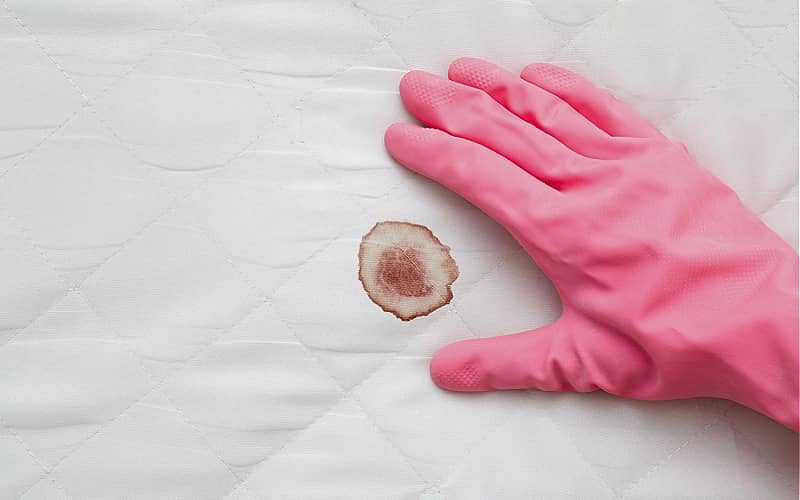
A fresh blood stain on a mattress is easier to clean, as it hasn’t set into the fibres yet. When dry, blood can be more difficult to remove than other types of stains.
It’s very important that you only use cold water when tackling a blood stain. Heat can “cook” the proteins and bind them to fibres, making the stain harder to remove.
For period blood, use paper towels to remove any menstrual clots from the sheets and mattress.
Using cold water and salt
If the blood stain is very new (less than 30 minutes), you may be able to remove it with plain cold water and salt.
Soak a soft cloth in cold water and wring it out, then use it to blot the stain. The cloth will keep the stain damp and help absorb the blood.
Once there’s no more blood transfer, sprinkle a layer of salt over the stain. Wait 30–60 minutes so it can absorb any remaining moisture and blood.
Vacuum up the dried salt or wipe it off with a clean cloth.
Using hydrogen peroxide
For dried blood stains, 3% hydrogen peroxide is your best bet! H2O2 breaks down proteins in blood and makes it easier to remove the stains.
Avoid using this method on a foam mattress unless necessary, as peroxide can bleach or damage the foam. Instead, look for a foam-safe enzyme cleaner.
To remove old blood stains, use a soft sponge to apply hydrogen peroxide directly to the affected area. There may be mild fizzing as the product reacts with the blood.
Rinse the sponge if it gets too dirty, then apply more peroxide. Keep dabbing the mattress until the stain has lifted.
How to Remove Drink Stains From a Mattress

When it comes to tea and wine stains, the trickiest part is washing out the tannins, especially on a light-coloured mattress.
Coffee also has tannins, but the bigger problem is milk! If any milk gets into your mattress — and yes, instant coffee may contain milk powder or creamer — it can quickly spoil and lead to mould growth.
If you can’t get all the coffee out ASAP, it’s better to have your mattress professionally cleaned.
Using soda water
This cleaning solution works on new stains that haven’t dried or set. Soda water (aka club soda) contains carbonic acid, which helps break up a stain and lift it from fibres.
Use clear, unflavoured soda water so it won’t leave any colouring on the mattress.
Pour a good amount of soda water onto the surface, enough to saturate the stain. Leave it to sit for a few hours, then blot up the stain with a damp cloth.
Repeat until the stain has completely lifted.
You can also sprinkle a small amount of salt before applying the club soda. The salt will help absorb moisture — just don’t use too much, or it’ll take a while to clean up.
Using a carpet or steam cleaner
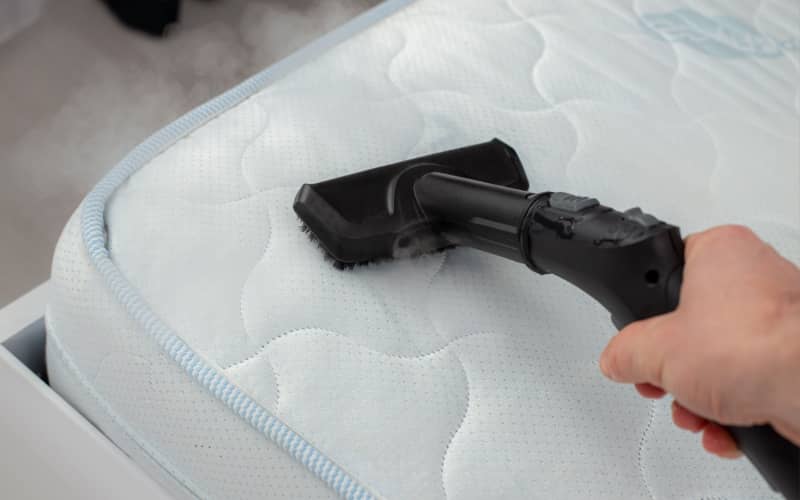
For dried stains (or anything with milk), a steam cleaner is the most thorough solution. The steam penetrates the mattress to remove deep stains.
Do not use a steam cleaner on memory foam, as the heat and moisture can damage the material.
Follow the manufacturer’s recommendations for mattress cleaning. Afterwards, place the mattress in a well-ventilated space so it can air dry.
If possible, elevate the mattress or position it so all sides are exposed. Otherwise, flip the mattress every few hours to ensure it dries evenly.
You can speed up the process by pointing an electric fan at the mattress or using a blow dryer on the cold setting.
How to Clean Vomit Off a Mattress
Maybe your kid is sick, or your pet ate something it shouldn’t have. Accidents happen, but the sooner you deal with them, the better.
Always wear rubber gloves and a face mask when cleaning up vomit, especially if someone is ill. You want to stay safe and hygienic!
Start by removing any solids with paper towels or scraping up the mess with a paper plate.
Afterwards, strip the bed and wash the sheets using the hottest setting possible. You can add laundry bleach or a similar disinfectant to the washer.
Blot any excess moisture from the mattress with more paper towels or rags. Don’t scrub or you’ll push the vomit further into the material.
Enzyme-based cleaners are the most effective at removing vomit from a mattress. The enzymes are formulated to break down organic matter.
Follow the product instructions and be sure to cover the entire vomit stain. Allow the mattress to air dry afterwards.
Finally, disinfect the mattress. Refer to the enzyme cleaner label for how long to wait until the product fully dries — it may take several hours.
Thoroughly spray the mattress with 70% rubbing alcohol or (if it’s safe for the material) 3% hydrogen peroxide. For non-memory foam mattresses, you can use a handheld steam cleaner.
Leave the mattress to dry in a well-ventilated space.
How to Clean Urine Stains on a Mattress
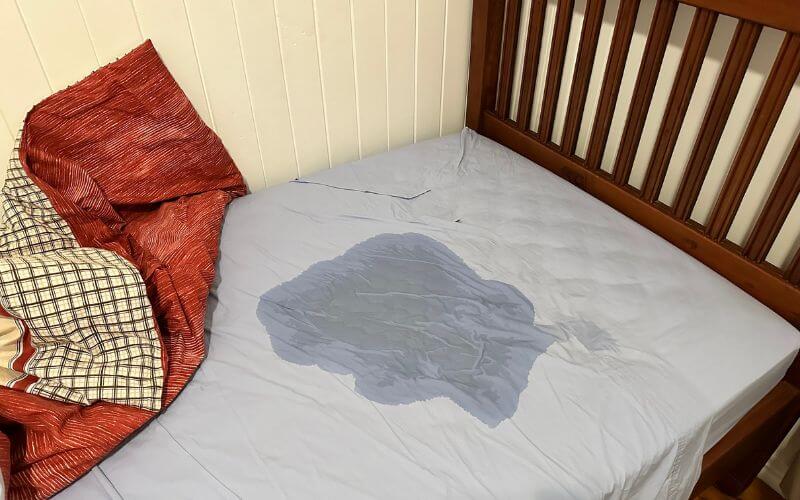
Tackle urine stains on a mattress ASAP — the more pee soaks in, the harder it is to fully remove. Any trapped urine will cause an unpleasant odour that lingers for days.
Start by getting as much urine out of the mattress as possible. A wet/dry vacuum is the most efficient method, but make sure to clean it thoroughly afterwards.
Since they’re more absorbent, foam mattresses need extra effort to eliminate pee stains and smells.
Using citric acid
Citric acid powder is a versatile household cleaner and can tackle a variety of household messes. It works well on fresh urine stains, as the acid can help dissolve the pee compounds.
Just be careful when using it on dark fabrics, as it has a mild bleaching effect.
To make a mattress steam cleaner with citric acid, mix the powder with warm water at a 5% concentration. For a cup of water (250ml), use about 1 tbsp (14ml) of citric acid powder.
Wet a sponge with the cleaning solution and apply it to the urine stain. Let the solution sit for a few hours before wiping off the citric acid residue with a damp cloth.
Repeat until the stain has lifted, then let the mattress dry.
Using an enzyme cleaner
For dried urine stains or pet messes, you’ll need a stronger solution.
Pet enzyme cleaners are formulated to tackle tough pee stains and odours — and yes, they’ll work on human urine, too. The enzymes will break down urine compounds and make them easier to clean up.
Follow the product instructions carefully and let the mattress dry in a well-ventilated space.
Tips for Preventing Stains and Mattress Maintenance
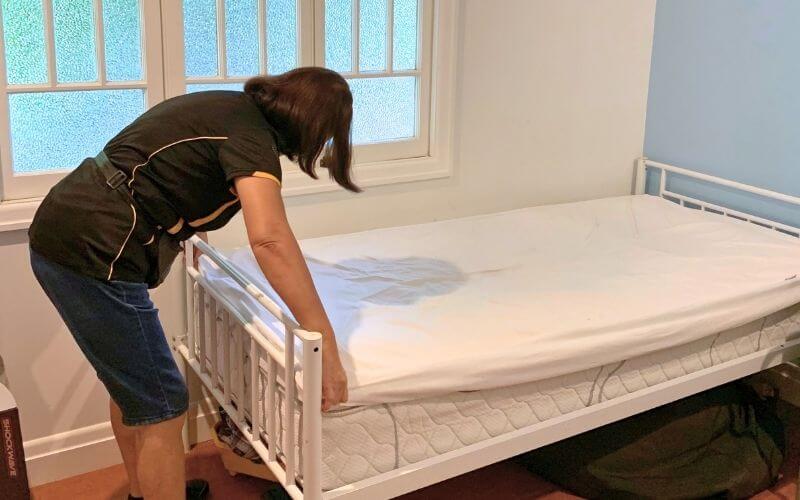
Consider getting a waterproof mattress protector or a washable mattress pad! These can prevent stains, as well as keep out dirt and dust mites.
It’s also easier to wash a mattress protector, which streamlines the cleaning process.
Spot-clean minor mattress stains and vacuum the surface whenever you change your bed sheets.
Also, let your mattress air out before putting on new bedding — it’ll help keep things fresh and minimise moisture build-up.
For pet owners, keep them off your bed until they’re fully potty trained. If you notice repeated “marking” with urine, consult a trainer or vet so you can deter the behaviour.
Besides the mattress and sheets, keep the rest of your bedroom clean as well. A dirty or messy bedroom can cause dust, pet hair, and other dirt to accumulate on your bed more quickly.
Make things easier by scheduling a pro home cleaner to spruce up your bedroom… and hey, might as well get every other room cleaned, too!

